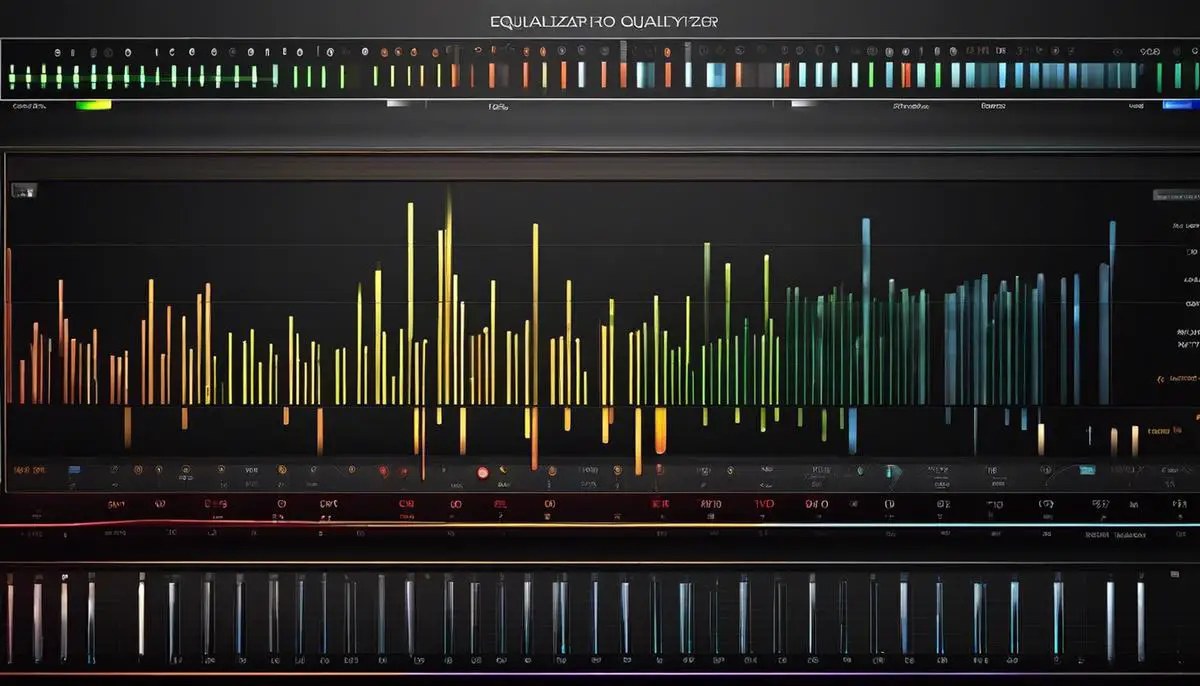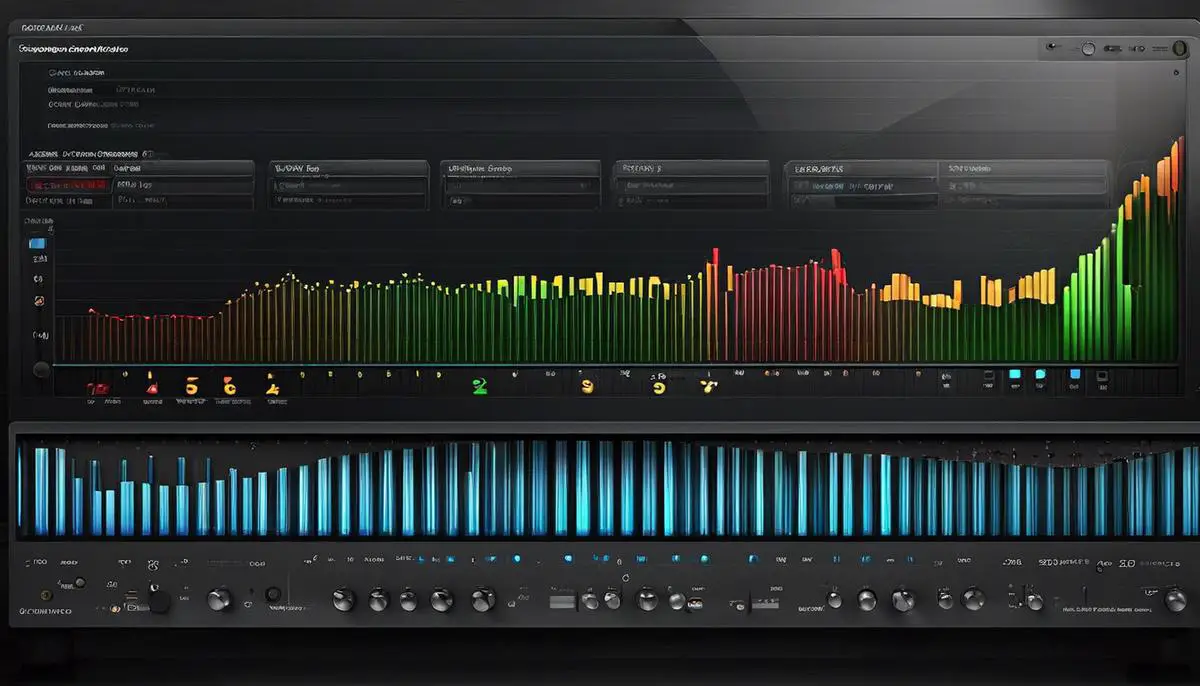Embarking on an auditory journey to elevate your gaming and music experience requires a fundamental understanding of the tools at your disposal. Equalizers, intricate but accessible, are the gateway to an immersive soundscape, allowing connoisseurs and newcomers alike to sculpt the sound that resonates most profoundly with their individual taste. This essay delves into the essence of equalizers, demystifies their various types, and outlines their role in enhancing audio quality for diverse acoustic adventures. By mastering the art of adjusting frequency components, you will unlock a world where every boom, whisper, or melody in your games and music is tailored to thrill your senses. Let’s embark on this sonic exploration together, harnessing the power of equalizers to create an auditory experience as unique as your fingerprint.
Understanding Equalizers
Dial In Your Audio Experience: Understanding Equalizers in Gaming and Music
An equalizer, or EQ, is a critical tool for any tech enthusiast looking to achieve the ultimate audio experience in both gaming and music. With the digital world constantly advancing, the proper use of an equalizer can catapult a standard sonic experience to a custom-tailored soundscape that meets the precision of analytical minds and the desires of audiophiles alike.
At its core, an equalizer allows for the adjustment of different frequency bands within an audio signal. By fine-tuning these frequencies, users can emphasize or diminish certain aspects of the sound, be it the deep thrum of a bass line or the crispness of a high-hat. When it comes to gaming and music, these adjustments aren’t just about preference—they can be about performance.
For gamers, audio cues are paramount. Equalization can bring footsteps, gunfire, and environmental audio cues to the forefront, without drowning in overpowering background music or unnecessary noise. Custom EQ settings can make or break the gaming experience, providing gamers with the competitive edge needed to react faster than opponents or fully immerse themselves within a virtual world.
Music lovers, on the other hand, use equalizers to enhance listening pleasure. Whether it’s to compensate for less-than-ideal speaker setups, to adapt to the acoustics of a room, or simply to adjust to personal taste, EQ adjustments can resurrect details in music that might otherwise go unnoticed. Audiophiles relish in the ability to dissect and elevate individual instruments, vocals, and compositional elements within a track, creating a rich, full-bodied listening experience.
To harness the power of an equalizer for gaming or music, follow these steps:
- Identify Your Equipment: Make sure your gaming setup or audio playback device is EQ-capable, which is common in most modern sound systems and gaming headsets.
- Understand Frequencies: Learn the basic frequency ranges (low, mid, and high) and which types of sound correlates with each range. For example, bass tones usually sit in the low-frequency range, while vocals can be found in the mid-range.
- Reference Presets: Start with EQ presets that might be offered by your audio device or software, such as “Rock” for music or “FPS” (First-Person Shooter) for gaming, to get an idea of how these settings impact sound.
- Adjust Manually: Tweak the EQ bands manually to match your specific audio needs. Up the ante on the lower frequencies to give impactful explosions in games more rumble or clear up the mids and highs for crystalline dialogue and music vocals.
- Audiometric Adjustments: Assess and adjust based on the game genre or music type. Each has its optimal profile; for instance, an action game may benefit from booming lows, while classical music might shine with enhanced mid and high frequencies.
- Test & Iterate: Listen closely and adjust the bands during different gaming or listening scenarios. Take note of what sounds better and make incremental adjustments.
- Save Profiles: Once you’ve found the perfect balance, save these settings as custom profiles to easily switch between optimized audio for gaming or music.
Remember, the goal of using an equalizer is to enhance the personal audio experience, whether that’s by gaining a competitive edge in gaming or extracting the utmost enjoyment from a favorite album. The right EQ settings will breathe life into audio, making technology enthusiasts wonder how they ever settled for default sound profiles. Happy tuning!

Identifying Optimal EQ Presets
Selecting the best equalizer presets hinges on multiple factors. These include the type of content immersive in, the qualities of the audio system or headphones, and personal preferences. Here are actionable steps to precisely tailor equalizer settings for gaming and music enjoyment.
For Gaming:- Prioritize Highs and Mids: Gamers should focus on frequencies that heighten footsteps, dialogue, and environmental sounds. This typically involves boosting mid to high frequencies (around 1,000 Hz to 6,000 Hz). Enhancing these ranges can provide more precise directional cues and clarity in chaotic gaming environments.
- Don’t Overlook Lows: While the high-mids are important, don’t completely neglect the bass frequencies (around 20 Hz to 250 Hz). A slight boost can enrich the gaming experience by giving explosions and soundtrack bass lines the appropriate depth, without drowning other critical sounds.
- Consider Game Genre: Different game genres demand different EQ settings. For instance, FPS games require precision for sound cues like footsteps, necessitating a higher-mid boost. In contrast, an RPG might call for a more balanced or cinematic preset to appreciate the game’s broader range of frequencies.
- Avoid Clipping: Over-amplifying any frequency band can lead to distortion or ‘clipping.’ Keep adjustments moderate; a heavy hand in one direction can corrupt sound quality.
- Use Surround Sound Feature Judiciously: If using surround sound, ensure it harmonizes with the EQ settings to enhance the spatial audio without over-processing the sound.
- Match Genres with Profiles: While listening to music, different genres benefit from different EQ settings. Classical music typically requires a flat or natural sound profile, emphasizing clarity across all frequencies. Conversely, rock or pop may benefit from a slight boost in bass and high-mids for punchier drums and clearer vocals.
- Fine-tune According to Taste: Some listeners prefer prominent vocals, while others like deep bass lines. Adjust the mid-range frequencies (around 500 Hz to 2,000 Hz) for vocals and the lower frequencies for bass as per preference.
- Account for Audio Hardware: Not all speakers or headphones are created equal. Determine if the playback device naturally accentuates or dims certain frequencies and adjust EQ settings to compensate.
- Adjust for Environment: Room acoustics add another layer to consider. Large, sparsely furnished rooms can make sounds feel flat, whereas smaller, cluttered spaces might create echos. Use EQ settings to mitigate these effects and create a balanced listening environment.
- Keep Highs Crisp without Sibilance: The treble or high-end (above 6,000 Hz) should be crisp and clear without causing ear fatigue. Sibilance (sharp “s” sounds) can be attenuated by dialing back frequencies around 5,000 Hz to 8,000 Hz.
- Be Dynamic: As tracks switch, be prepared to adjust. This isn’t fixed science, but an ongoing process to suit the immediate listening context. Utilize equalizer presets as starting points but be dynamic with manual tweaks.
In conclusion, arriving at the perfect equalizer setting is a personalized journey, dependent not just on one’s hearing preferences, but equally on the gaming or musical content, environmental factors, and audio equipment being used. Continuously tweak and refine to achieve that sweet spot where sound truly comes to life.

Customizing Equalizer Settings
Fine-tuning equalizer settings goes well beyond the preset profiles. It’s an art that requires meticulous attention to how each frequency band interacts with others. There’s a methodical approach to sculpting the perfect sound—a fusion of science and personal preference that delivers an unparalleled auditory experience.
Start with a baseline: Before jumping into complex tweaks, ensure that your audio output is neutral. Disable any enhancements or effects that could color the sound, guaranteeing a blank canvas for EQ adjustments.
Understand the nuances of frequencies:
- Sub-bass (20 to 60 Hz): Feel the rumble without muddying the mix? Adjust sub-bass to add depth, but be wary of overwhelming other elements.
- Bass (60 to 250 Hz): Aim for a balanced bass that supports, not dominates. Excessive bass boosts can lead to a boomy outcome, detracting from clarity.
- Low-mids (250 to 500 Hz): This range is tricky—it can provide warmth or cause muddiness. Cut or boost cautiously, ensuring vocals and instruments are distinct.
- Mids (500 Hz to 2 kHz): Carve out space for critical elements like lead vocals. A surgical approach ensures each instrument breathes without clutter.
- Upper-mids (2 to 4 kHz): This presence region can highlight particular nuances in music or gaming effects. Amplify modestly to bring detail forward without introducing harshness.
- Highs (4 to 6 kHz): Sharpness lives here. A slight increase can increase definition, but overemphasis might lead to listener fatigue.
- Brilliance (6 to 20 kHz): Air and sparkle come from this ether—they should be touched lightly. Enhance ever so slightly for a sense of openness without introducing sibilance.
Leverage advanced tools: Instead of relying on graphic EQs alone, experiment with parametric EQs. They offer more precise control over frequency, bandwidth (Q), and gain. Fashion intricate frequency curves that a graphic EQ could never achieve.
Adapt to content: What works for one song or game might not for another. Be flexible and ready to make subtle changes based on the media’s demands. A rock track might need a different touch compared to a jazz piece—consider each piece’s unique characteristics.
Monitor volume levels: Post-EQ, volume can skew perception. Ensure playback levels are consistent when A/B testing changes—our ears can deceive us into thinking louder is better.
Reference with different equipment: Don’t get trapped in the bubble of one listening device. Check adjustments across various speakers and headphones—what sounds incredible on one might be lackluster on another.
Utilize software analyzers: These tools display the frequency spectrum in real-time, offering a visual aid to what’s heard. Utilize them to spot problematic frequencies or to confirm the effectiveness of EQ tweaks.
Remember the critical listening environment: It’s not only about the EQ settings but also where the listening takes place. The room’s acoustics play a substantial role—sound treatment or correction software may be necessary for accurate sound.
Integrate mobile apps: Harness smartphone apps like REW (Room EQ Wizard) that measure room acoustics. The data collected can inform thoughtful adjustments counteracting any inherent sonic flaws in the listening space.
Bypass traditional EQ: Explore convolution reverbs and impulse responses (IRs). These are advanced tools taken from recording studios that simulate different acoustic environments and speaker characteristics, carrying potential for refined equalization through a different lens.
Avoid the allure of visual EQ curves: It’s about how it sounds, not how the EQ curve appears. Don’t sculpt a visually appealing curve at the cost of audio fidelity.
Finally, trust your ears: Every adjustment should pass the ultimate test—does it sound better? If a tweak fails to serve the audio, it doesn’t belong. Stay iterative, remain patient, and enjoy the journey to audio nirvana.

The journey through the frequencies and waves of sound culminates in an empowering realization: the control to shape our auditory environment is at our fingertips. Stepping away from the equalizer, we now possess the knowledge to not only understand its functions but to manipulate it in ways that enrich our gaming battles and breathe life into the rhythms of our favorite tunes. Your personal orchestration of bass, mids, and trebles can transform the mundane into the extraordinary, resonating with the very essence of your listening preferences. Armed with optimal EQ presets and customization skills, every digital interaction and musical interlude promises to be a testament to your newfound sonic prowess, a harmonious blend crafted uniquely by you, for you.
- Guide to Life Is Strange: True Colors Ch. 1 Choices - April 4, 2024
- Catching Spiritomb in Pokemon BDSP - April 4, 2024
- Mastering Life Is Strange: Key Choices in Chapter 1 - April 4, 2024
Views: 21









